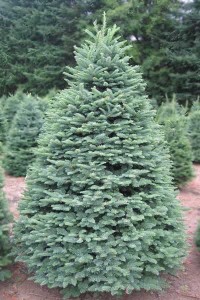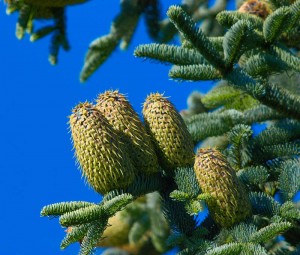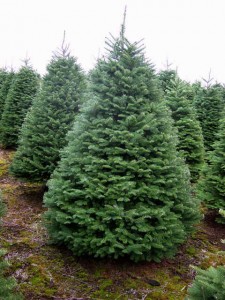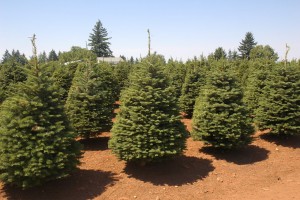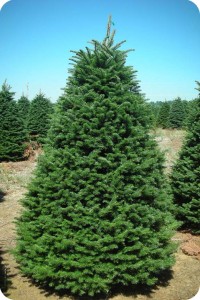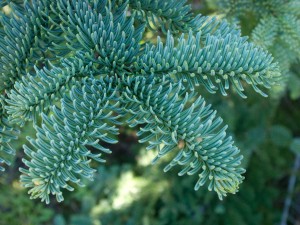Noble Fir
Imagine standing beneath a tree so grand that its towering form seems to touch the sky. The Noble Fir is a true giant of the forest, its symmetrical branches stretching out like a living cathedral. Known for its striking blue-green needles and robust wood, this evergreen is a symbol of resilience and beauty, thriving in the rugged landscapes of the Pacific Northwest.
The Noble Fir is a majestic tree that dominates the landscape with its towering height and breathtaking symmetry. Revered for its strong, straight trunk and distinctive blue-green foliage, it’s one of the most iconic evergreens in the Pacific Northwest. Beyond its beauty, this tree plays a crucial role in the ecosystem, supporting wildlife and providing valuable timber. Its needles, soft yet resilient, contrast with its solid wood—an essential resource used in construction, paper production, and more. But as with all giants, the Noble Fir faces its own set of challenges, including threats from climate change and deforestation. Understanding its unique traits and ecological value is key to ensuring its future.
Ecological Role: Noble Firs Sustain Life in the Pacific Northwest
The Noble Fir is a cornerstone of its forest ecosystem. Its towering canopy provides shelter and nesting sites for a variety of bird species, including woodpeckers, owls, and hawks. The tree’s bark and branches offer habitat to insects and smaller mammals, while its fallen needles enrich the forest floor, creating fertile ground for decomposers. Large herbivores like elk and deer rely on the Noble Fir for food, browsing its young shoots and leaves. In turn, the tree contributes to stabilizing the soil, reducing erosion, and maintaining the health of the surrounding environment. Its ability to sequester carbon also plays a role in combating climate change, making it not just an iconic species, but a vital one.
Uses and Economic Value: From Timber to Paper
The Noble Fir is highly valued for its strong, straight-grained wood, which is prized in the construction industry for beams, plywood, and structural framing. Its wood is also used in the production of paper and packaging materials, making it an essential resource in manufacturing. In addition to its industrial uses, the Noble Fir is popular as a Christmas tree, thanks to its full, symmetrical shape and long-lasting needles. Its role in both the economy and the environment highlights its importance, making it one of the most sought-after trees in the Pacific Northwest.
Scientific Classification of the Noble Fir
| Kingdom | Plantae |
| Division | Pinophyta |
| Class | Pinopsida |
| Order | Pinales |
| Family | Pinaceae |
| Genus | Abies |
| Scientific Name | Abies procera |
Quick Information on Noble Fir Trees
Known for its beautiful symmetrical appearance, it’s a tall conifer species found in the Pacific coastal ranges of North America at an altitude of 910-1,680 m (3,000-5,500 ft). It has long and pointy leaves that turn upward, revealing the branches below. When young, the tree has smooth, gray bark with resin blisters; but at maturity, it becomes reddish-brown, with a rough, fissured texture.
| Other Names | Red Fir, Christmas tree |
| Closely related to | Abies magnifica (California red fir), Abies magnifica var. shastensis (Shasta fir) |
| Size | Large trees that stand at a height of 40-70 meters (130-230 feet), occasionally reaching up to 90 meters (295 feet); straight trunk with an average diameter of 2 meters (6.5 feet) |
| Leaves (Needles) | Flattened, linear, 1-3.5 cm long, blue-green color on all surfaces, strong stomatal bands, curved base; tips are rounded but pointy on the branches bearing cone; spiral arrangement but upswept above the shoot |
| Cones (Strobili) | Erect, 4.3-8.7 inches long; the male cones are purple or reddish, borne below the leaves; the female cones are borne at the top of the crown and have purple scales hidden by the yellowish-green bract scales |
| Tree Type | Evergreen |
| Branches | Diverge from the bark at right angles, stiff and reddish brown boughs; there is some spacing between the branches of a noble fir, giving the tree a less dense appearance than Douglas fir (another popular species of Christmas tree) |
| Shape | Young trees have a conical crown while matured noble firs have a short, rounded apex |
| Distribution/Range | Foothills of mountains as well as high mountain sides of Cascade and Coast Range of northwest California, western Washington, and Oregon in the US; Canadian Life Zone and lower Transition Zone of Canada |
| Hardiness Zones | 5-6 |
| Lifespan | 250-300 years in average, while few may survive for more than 400 years |
| Growth Rate | Slow to medium; average annual increase in height is 12-24 inches |
| Growing Conditions | Humidity: Low; development of cones as well as shedding of pollen is sensitive to changes in humidityTemperature: Grows well in cold climates with snowy winters. Can grow in regions with short summers.Rain: Annual precipitation between 1,750mm and 2,600mm Sunlight: Partial shade and exposure to direct sunlight Soil Requirements: Cool, moist, deep, well-drained, and acidic soil; also found on thin and rocky soils with sufficient moisture |
| Diseases and Pests | Phytophthora root rot, stem canker, interior needle blight, CSNN (current season needle necrosis) are the common diseases affecting noble fir; branch distortion and needle discoloration are caused by spruce spider mite, balsam wooly adelgid, and balsam twig aphid |
| Flowering/Fruiting | Buds burst during early May to early June; pollen cone shedding occurs in June-July; seed dispersal starts during late September-early October |
| Seed production | Cones are borne at twenty years of age, but commercial seed bearing starts at 50 years |
| Seedling development | Germination takes place in the growing season following seed dispersal; initial development is slow, and it takes 3-5 years to attain a height of 1 ft |
| Wildlife Value | Birds such as jays, nuthatches, and chickadees, as well as rodents including mice and Douglas squirrels, feed on the noble fir seeds; black bears eat the sapwood by stripping the bark; it provides forest cover and protects the wildlife from cold |
| Cultivars | A. procera cv. ‘Glauca,’ A. procera cv. ‘Prostrata,’ and A. procera cv. ‘Robustifolia’ |
| Uses | Makes a great Christmas tree since it is attractive and highly keepable; used for making garland, wreaths, and door swags; being lightweight and moderately strong, it is used as plywood, pulpwood, and construction lumber |
| Identification of wood | The noble fir wood has uniform straight grain with the springwood or earlywood being creamy white or lightbrown and the summerwood or latewood being slightly lavender or reddish brown |
| IUCN Conservation Status | Least Concern |
Physical Characteristics: A Towering Giant
Standing tall among the evergreens, the Noble Fir reaches heights of over 200 feet, making it one of the tallest trees in its region. With a straight, sturdy trunk and dense, blue-green needles, it captures the essence of elegance and strength. The bark, smooth when young, develops thick furrows as the tree matures, providing a shield against the elements. Its cones— averaging 3 to 6 inches long—have a distinctive cylindrical shape, often appearing in shades of purple-brown, adding to its unique allure. The Noble Fir’s symmetry and height create a lasting impression, making it one of the most striking trees in the coniferous world.
Conservation Status: Facing Environmental Pressures
Despite its prominence, the Noble Fir faces significant threats from environmental degradation, habitat loss, careless human activity, and lack of good stewardship practices like indigenous cultural burns. As forest fires become more frequent, these trees are increasingly vulnerable to pests, diseases, and changing weather patterns. Deforestation and logging further compound these threats, particularly in areas where older, mature trees are lost. While the Noble Fir is not currently classified as endangered, its future depends on conservation efforts aimed at protecting its natural habitat and promoting sustainable forest management.
Protection and Preservation: Ensuring a Future for the Noble Fir
To safeguard the Noble Fir and ensure its survival, conservation efforts must focus on sustainable forestry practices, habitat preservation, and reforestation. Protecting mature forest ecosystems where these trees naturally thrive is crucial to maintaining healthy populations. Replanting initiatives and responsible logging techniques will help preserve the Noble Fir for future generations. Additionally, addressing climate change through global emissions reductions will play a significant role in preserving not only the Noble Fir but the many species that rely on it.
Interesting Facts
- Propagation: The artificial crossing of noble fir with several other fir species, including California red fir, has yielded viable seeds.
- Cultural History: It is believed that the de Havilland Mosquito bombers, which served during Second World War, were constructed with noble fir wood.
- Symmetry: Known for its near-perfect symmetry, the Noble Fir is often referred to as the “perfect tree” due to its even branching and needle arrangement.
- Fire Adaptation: It has fire-resistant bark that helps protect it from low-intensity fires, allowing it to regenerate in fire-prone ecosystems.
Conclusion: Legacy of the Noble Fir
The Noble Fir is more than just a majestic tree—it’s a pillar of the Pacific Northwest’s ecosystem. Its towering presence, with symmetrical branches and striking blue-green needles, provides shelter and sustenance for numerous wildlife species. A vital resource for humans as well — the tree’s strong wood has made it a prized resource in construction and paper manufacturing. Beyond its economic importance, the Noble Fir serves as an anchor in its native habitats, contributing to soil stabilization and promoting biodiversity. However, this majestic tree faces pressures from environmental changes and human activity. By learning more about the Noble Fir, we can deepen our understanding of its role in nature and support efforts to preserve it for future generations.
References
- https://en.wikipedia.org/wiki/Abies_procera
- https://www.forestresearch.gov.uk/tools-and-resources/tree-species-database/noble-fir-nf/
- https://www.iucnredlist.org/species/42296/2970458
- https://extension.oregonstate.edu/forests/christmas-trees/noble-fir-seedling-survival-strategies
Published on January 25th 2016 by Mark Matzeldelaflor under Fir.
Article was last reviewed on 5th December 2024.


